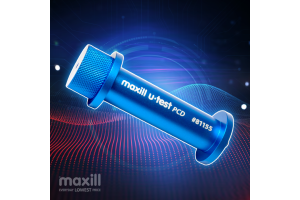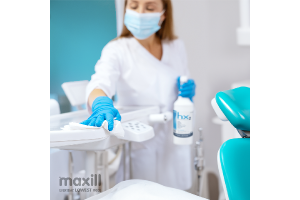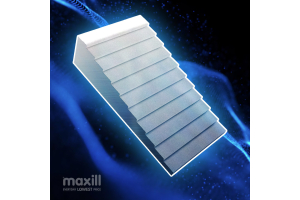Is Your Impression Taking Making a ‘Good Impression’?

Although digital imaging is at the forefront of dentistry, not every office has a digital scanner or a second or third scanner to fully eliminate manual impression taking. In every office there seems to always be the one or two impression guru’s that constantly capture a fabulous impression. You too can be an impression guru with the review of some simple elements and skills that can deliver a more predictable ‘good impression’ organized with proper planning.
Impression Tray Design
The impression tray is the base of the impression; what holds the impression, so it should do just that ‘hold the impression’ and do it well. We have all experienced the moment when you pull the impression out of the mouth and the tray comes out but not the impression material. Yikes! Not a great feeling (for both client and clinician). The selection of the tray itself is important to ensure it has enough surface attachment to hold the material while you are ‘yanking’ at it! This plays a larger role with full arch impressions keeping in mind the various types of trays: regular, quadrant, dual, orthodontic and anodontia. Even the smaller quadrant or dual impression trays have a mesh design to lock the impression material for when the pulling unfolds to remove it from the teeth. The orthodontic trays have even more traction to account for the extra hardware on the teeth where the impression material will need to be carefully pried from. Investigate the tray inventory in the dental office, is there a variety to ensure the design matches the clients needs to offer reliability in securing the impression material?
Impression Tray Size & Tailoring
One size does not fit all! It is important to determine what size the client needs otherwise if it's too small, areas will be missed and if it's too big, well areas will also be missed as it will be impossible to properly seat the tray. What if the client is between two sizes of trays? That is where the lovely rope wax comes into play and the tray size may require some modification. In essence, there are times when the tray needs to be tailored to fit the clients mouth. The intraoral structures need to be screened. Does the client have a large palatal vault, palatal tori, anatomical ridge variances, mandibular tori, strong lips, a tongue that will fight you to the bitter end, etc? Take the time to find the ideal fit for the client prior to the insertion of the loaded tray.
Setting Times: Temperature & Gloves
The temperature in the office does have an impact on the setting time of some materials. The more humid and warm temperatures can accelerate the setting time. No different than purposely speeding up the setting time of alginate by mixing it with warm water. Not many offices use latex gloves, nonetheless, this still requires a mention. Some latex gloves can interfere with the setting of VPS materials. As for nitrile gloves, a study by Delgado et al compared the interaction of bare hands, unwashed nitrile gloves and washed nitrile gloves when manipulating the VPS putty material. One may wonder why the VPS putty would be handled with bare hands? Do not worry, this will be addressed in the next article about asepsis and impression taking. The study concluded the following:
“The mean gelation time of hand contaminated specimens was 157.50 minutes and was significantly slower than that by using nitrile washed gloves (mean=117.94, p=.004) and by using unwashed gloves (mean=99.46, p(0.001). Unwashed gloves had a significantly quicker gelation times compared to washed gloves (p=.046). Hand contaminated specimens were affected by the gelation/polymerization time.”1
Mixing Skills
If using alginate , the typical approach is mixing a designated ratio of powder to water. As stated above the temperature of the water impacts the setting time of the material. This can be good and bad. Good if you are trying to alter the setting time but poor if that is not the goal. There are times where accelerating the setting time is desired, for example, a client that will not tolerate the procedure well, or/and a client with a high gag reflex. There are times where decelerating the setting time is desired, for example, the nervous client that requires the extra pep talk right before you enter intra-orally with the loaded tray.
Mixing a homogenous product is the desired end result. This requires an alginate bowl and spatula that are the right size and shape to accomplish an efficient and effective mix. Many offices use an alginate bowl that is too large, did you know there are different size alginate bowls? A one arch mix of alginate in a bowl too large will require more ‘scooping’ from the sides of the bowl when trying to load the tray with the spatula. This consumes more time and as time marches on the alginate is setting quicker and quicker. Are you using the spatula that suits your hands? The spatula size and handle make a difference for the dexterity of the clinician mixing and loading the tray. The selection of spatulas includes: wand, wave handle and ergonomic handle. If you are taking many impressions daily, the right spatula is important to prevent hand and arm injuries.
Air bubbles in a powder/water mix is at the mercy of the clinician’s mixing skills. This is where the spatula and bowl size also play a role. To remove air bubbles or prevent them, the idea is to ‘smoosh’ the material with pressure against the edges of the bowl. That is simple if you can hold the bowl steady and if your spatula covers a large and controlled surface area. What about the asepsis of the alginate bowl and spatula? Don’t worry that’s the next blog article!
If the material being mixed is a cartridge style it can be dispensed with the impression ‘gun’ or an automated machine; both producing a homogenous outcome. In both delivery systems there are still some issues that can arise. An important step is to slightly bleed the cartridges to ensure there are no dry particles or a large blob of dry material. Following the manufacturers instructions for the ideal storage temperature is important, as like the powder/water mix, the setting times can be altered with a temperature range that is too high or too low. Having extremes in viscosity, low or high, are both unwanted.
Loading and Seating the Tray
An improper load of impression material onto a tray is very predictable of a poor outcome. Uniformity in the material throughout the entire tray is key. What about adding material to areas already predicted of being an issue in capturing a ‘good impression’? Yes, this is a ‘thing’, and many clinicians can attest to having swabbed a high palate with a finger full of alginate in knowing too well the high vault will not be captured by the tray. This technique can also be used in long vestibule areas where again the worry for the impression paste loaded in the tray not reaching far enough to capture the anatomy required (example: frenum(s)).
Slow and steady wins the alginate race! A loaded tray is best inserted slowly and parallel to the long axes of the teeth, going in the direction of the teeth in a slow secure movement avoiding rocking the tray. Any sudden movements away from the slow and steady may cause distortion in the material.
Removal of the Tray
The very first time any clinician removes a set impression, well, it's slightly alarming as the common thought is ‘will this even come out’? Back to the setting times, the clinician will check if the material is set and ready to remove. Prematurely removing the impression will not have a favourable outcome. We have used wording such as pulling, yanking, rocking, etc., as it does take some force to remove an impression. Ideally the edge of the impression and tray needs to be released with a finger along the buccal mucosa and once that ‘seal’ is broken it will come out with more ease. To fit your finger in the buccal mucosa area the client needs to close slightly, the client will not mind resting their mouth! The idea is to avoid unilateral rotations. There is a difference between moving the impression tray slightly back and forth to relief the suction effect against the teeth versus rotating the impression to cause distortion. Shortly in this article I am addressing communication during the removal of a tray.
Medical History
Does a medical history screening matter to the simple procedure of impressions? It may not matter to the healthy dentition having impressions for ortho, a nightguard, or a sports guard, but it does matter to the dentition receiving major restorative treatment where a prep is being delivered followed by the placement of tissue retraction cord or retraction paste. The restorative impression such as a crown or bridge prep requires a clear working field to capture an accurate impression. Hemostasis is a crucial part of impression taking in restorative procedures. The client’s medical history needs to be screened to determine if there is an increased risk of bleeding. Various medications both prescribed and over the counter may have a side effect of increased bleeding. Considering, the straightforward prescription of blood thinners. Knowing this ahead of time will allow the clinician to select a suited retraction cord or paste possibly with the use of an astringent agent.
What about TMJ issues? The client with TMJ will also need special consideration as staying open with a bulky tray in their mouth may exacerbate the TMJ disorder.
Communication
Last but certainly not least! If a client has never had an impression, it can be an interesting procedure. No wait, not interesting, maybe horrifying! The ‘yanking’ the ‘rocking’ may seem to the client as very invasive and frightening. Many clients comment after the impression “I thought my teeth were going to be pulled out”. The comment by the dental professional to a client with a healthy dentition would be ‘no worries, you have healthy teeth and supportive bone, you did very well’. Have you ever taken what I call an ‘impression extraction’? I have many years ago at my first dental assisting job! I will never forget it! The impression was for a partial denture and of course there were mobile teeth. Although it is discussed in dental schools, nothing can prepare you for the look on the client’s face and yours (under your mask) when there is a tooth lodged in the alginate! So why not eliminate this awkward moment by knowing who you are taking an impression on and the status of their periodontal health? Sharing with the client what the impression ‘seating’ and ‘removing’ will feel like is very important. This includes discussing ahead the breathing technique you will need them to adhere to. Yes, the dental hat includes ‘Lamaze Coach’ during impressions.
When I was in dental hygiene school in Ottawa, ON, I joined one of my fellow classmates at her own dental appointment where the dentist was thrilled to have dental peers in his office. With my friend’s permission I was welcomed into the operatory for the impression taking to watch his technique as I was informed this dentist was THE impression guru. From the bib placement around my friend’s neck to the handing over of a wet towel after the impression he had ‘talked’ her through it in an approach that I label him as the ‘impression whisperer’. It was beautiful! He was so caring and so genuine as he indeed ‘coached’ her through the impression. Technique is certainly part of taking a good impression, but even with the best skills, if the client panics it's game over for the impression. The impression whisperer spoke with a gentle voice, did not rush, and it was ALL about the client in the chair.
For the client with mobile teeth, be fully transparent, state the forces of the impression removal may remove the teeth (you can always add humor and state you saved them money on paying for an extraction). In dentistry, the taking of impressions is an area where dental professionals may be a bit desensitized. As we take 1000 of impressions its not new to us, but it may be to the client. Time management is typically the barrier to this element of a ‘good impression’ or in this case a ‘good impression experience’. Many issues can be eliminated that impact the quality of the impression by simple communication. Pretend for EVERY impression you take, its YOUR first impression. What would you want to hear? What would you want to know? THAT conversation will deliver trust from the client’s perspective as it displays you know what you are talking about. The client will have confidence in YOU (look at you, impression guru you!).
Conclusion
As dental professionals go about their busy days with a vast array of knowledge and skill set, impressions are an area, although simple as a procedure, that carry many potential stressful implications for a poor outcome that can be avoided. Truly, its all about breaking down the steps of the impression taking and ensuring each step is planned before being executed. Deliberate planning delivers predictable outcomes. Add to the planning quality client centered communication and voila you’re an impression guru and maybe even on route to being a genuine impression whisperer! Take a good impression by making a good impression!
*** stay tuned for my next article on the IPAC of impression taking, trust me you will be surprised!***
Sources:
- Delgado, A J et al. “The Influence of Nitrile Gloves on the Setting Behavior of Polyvinyl Siloxane Putty Impression Materials.” The European journal of prosthodontics and restorative dentistry vol. 26,1 40-45. 1 Mar. 2018, doi:10.1922/EJPRD_01755Delgado06. https://pubmed.ncbi.nlm.nih.gov/29469997/.





